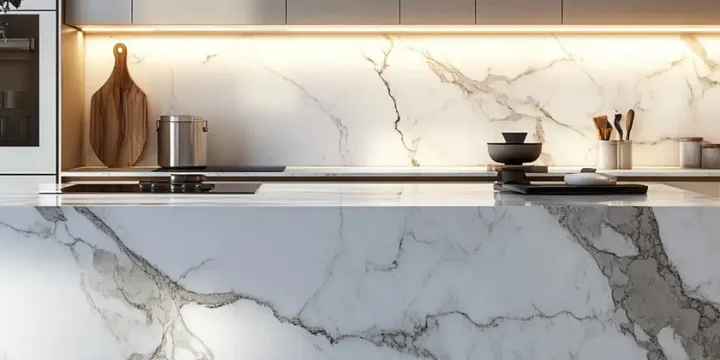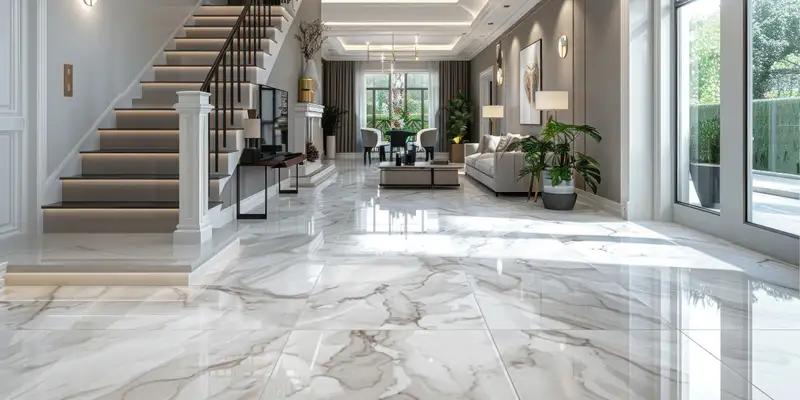What Is Marble? Formation, Extraction, Processing, and Uses
Marble has defined luxury for millennia—from classical temples and sculptures to today’s high-end interiors. This guide explains what marble is, how it forms, how it’s quarried and processed, where it performs best, and how to care for it for decades of beauty.

What Is Marble? Definition & Characteristics
Marble is a metamorphic rock that originates as limestone. Over millions of years, heat and tectonic pressure recrystallize limestone’s calcite into a denser, interlocking matrix with a signature crystalline shimmer. Mineral traces—iron oxides, graphite, clay—paint the stone with unique veining and color movement.
Key Characteristics
- Distinct veining: organic patterns unique to each block.
- Wide color range: snow-white to warm beiges, greys, and deep blacks.
- Luxurious finishes: polished, honed, brushed, leathered, tumbled.
- Versatility: floors, walls, bathrooms, kitchens, mosaics, and more.
Why It’s Coveted
- Visually elevates spaces with depth and light play.
- Pairs with both classic and contemporary design schemes.
- Adds long-term value when properly selected and maintained.
How Is Marble Formed?
The journey begins with limestone, a sedimentary rock composed primarily of calcium carbonate. Subjected to regional metamorphism—heat from rising magma and pressure from tectonic stress—the limestone recrystallizes. The result is marble: denser, stronger, and capable of taking a high polish. During this process, trace minerals and micro-impurities transform into delicate veins, clouds, and swirls that make each slab one-of-a-kind.
Renowned sources include Carrara (Italy), Afyon & Marmara (Türkiye), and Vermont (USA). Each region imparts distinctive tones and veining styles that designers recognize instantly.
Marble Extraction: From Quarry to Block
Quarrying marble is equal parts geology, engineering, and precision. The goal is to detach large, intact blocks—often several tons—while preserving structural integrity and aesthetics.
- Diamond wire saws: cut clean, accurate kerfs along bedding planes.
- Chain saws & channeling machines: open channels to free the block.
- Controlled splitting: hydraulic wedges or limited blasting to separate without fractures.
Once freed, blocks are graded for color and consistency, numbered, and transported to fabrication plants for transformation into slabs, tiles, and mosaics.
Processing: From Block to Slab & Tile
At the factory, blocks enter a well-choreographed sequence that optimizes both yield and quality:
- Block sawing: gang saws or multi-blade block cutters slice blocks into calibrated slabs.
- Reinforcement & resin: mesh backing and resin fill micro-fissures for stability.
- Finishing: polishing heads or brushes deliver polished, honed, leathered, or tumbled textures.
- Cut-to-size: standard tiles (e.g., 12×12, 18×18, 24×24) or custom formats; edge details added as needed.

Popular Surface Finishes
- Polished: mirror-like reflection, emphasizes color and veining.
- Honed: smooth matte, hides micro-wear on floors.
- Leathered/Brushed: textured sophistication with tactile interest.
- Tumbled: relaxed, antique feel—great for mosaics and shower floors.
Modern Applications
Marble’s adaptability makes it a top choice across residential and commercial programs:
- Flooring & wall cladding: hotel lobbies, living rooms, feature walls.
- Bathrooms & showers: vanities, tub surrounds, wet areas (with proper sealing).
- Kitchens: countertops and backsplashes; coasters and neutral cleaners recommended.
- Mosaics & moldings: accent borders, niches, decorative patterns.
- Outdoor use: select marbles can serve patios and walkways; verify slip resistance and freeze-thaw suitability by climate.
- Art & sculpture: prized for its fine grain and workability.
Advantages & Limitations
Advantages
- Timeless aesthetics and natural uniqueness.
- Broad palette of colors and patterns.
- Premium finishes elevate light and space.
- Increases perceived value of properties.
Limitations
- Porous by nature: requires periodic sealing.
- Acid-sensitive: lemon, vinegar, wine can etch; use pH-neutral cleaners.
- Needs mindful maintenance in heavy-use kitchens.
Care & Maintenance Tips
- Seal regularly: use a high-quality impregnating sealer per manufacturer guidance.
- Clean smart: pH-neutral stone cleaners; avoid acidic or abrasive products.
- Protect surfaces: use coasters, trivets, and felt pads under décor.
- Handle spills fast: blot—not wipe—to avoid spreading; address oil or wine quickly.
- Refresh sheen: professional polishing can restore brilliance after years of wear.
Pro tip: In kitchens, consider a honed or leathered finish to minimize the visibility of micro-etching from daily use.
Why Choose Marble from Stone Market USA?
At Stone Market USA, we curate premium marbles from renowned quarries and finish them to rigorous standards so architects, designers, contractors, and homeowners can specify with confidence.
- Extensive selection: classic whites, contemporary greys, warm beiges, dramatic veining.
- Multiple formats: slabs, tiles, mosaics, moldings—plus cut-to-size on request.
- Quality control: color consistency, calibration, and robust packaging.
- Nationwide shipping: reliable logistics for residential and commercial sites.
- Samples available: evaluate color and finish under your project lighting.

